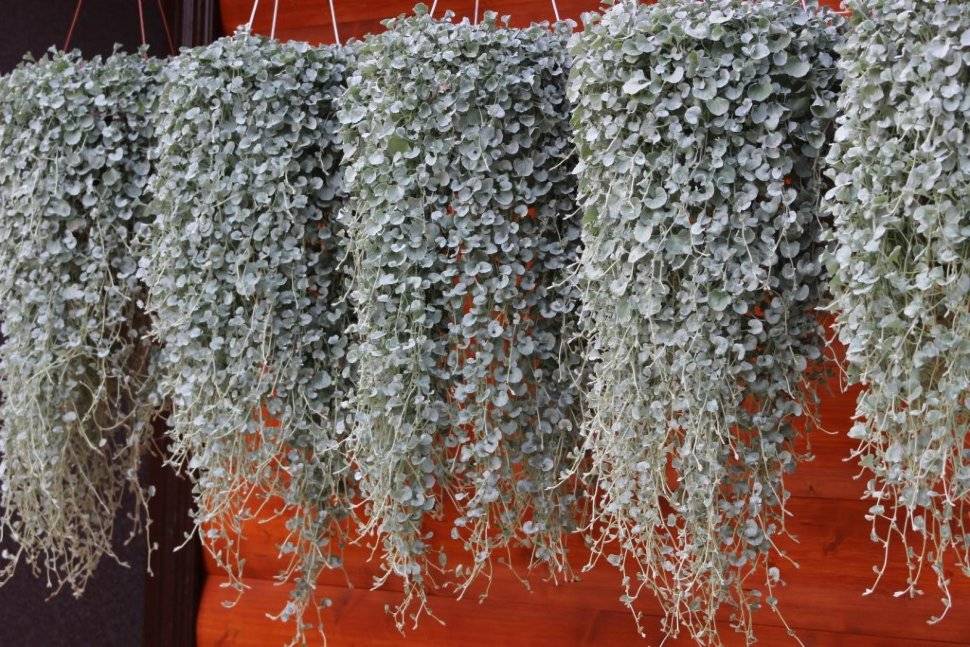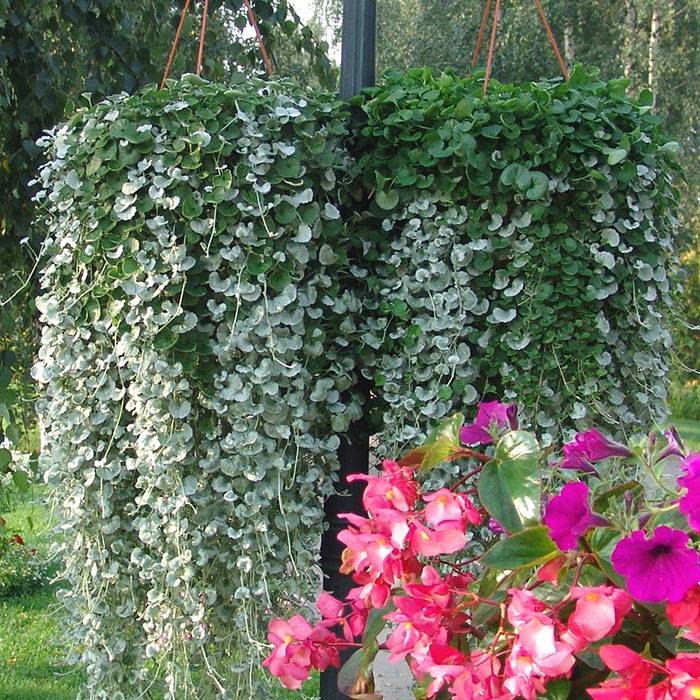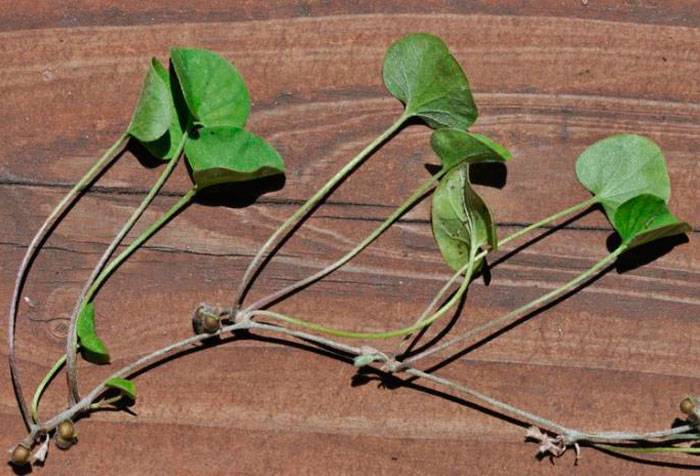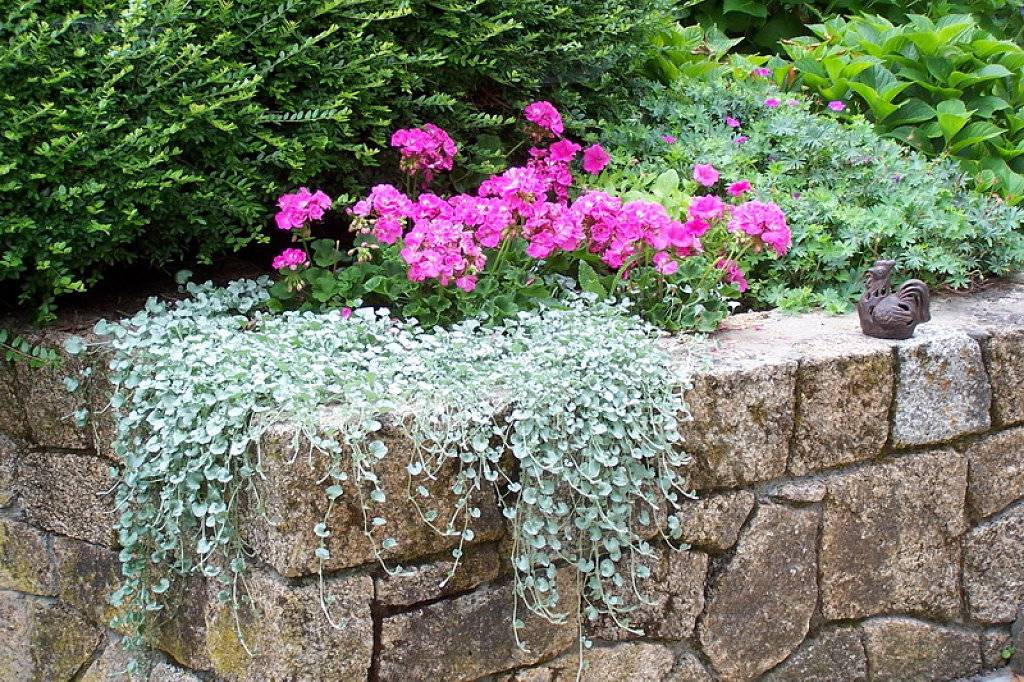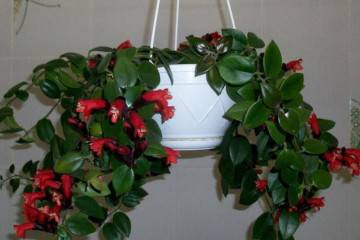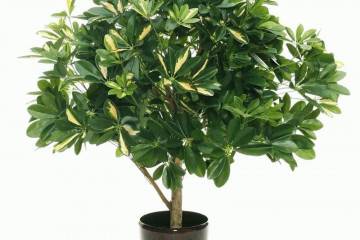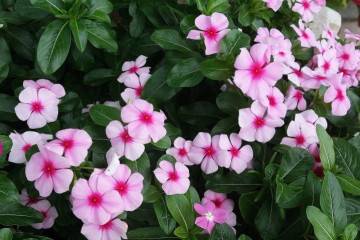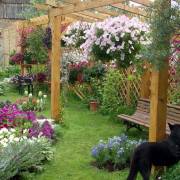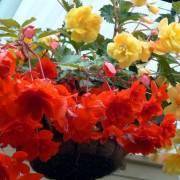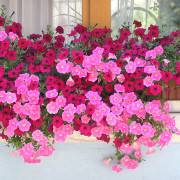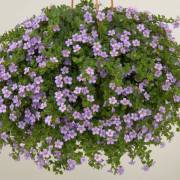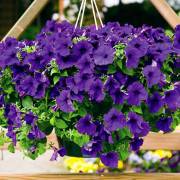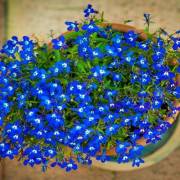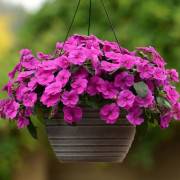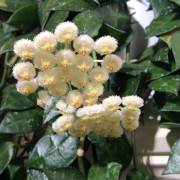Dichondra Flower Silver Waterfall or Silver Thread
Content:
Dichondra silvery waterfall is also called creeping waterfall. This ampelous plant is widely used for decorating various structures and in landscape design. Long shoots visually resemble streams of water.
Description of the plant
The dichondra flower is found naturally in America and Asia. Vines reach a length of 7 meters, but in artificial conditions they are more compact in size. The maximum length of cultivated varieties is 2 meters.
The dichondra plant got its name for the special structure of the fruit. They contain two grains. The shoots cascade down to create a beautiful visual effect.
Dichondra ampelous has small (no more than 2.5 cm in length) leaves. They are silver colored and have a rounded shape.
The plant can be grown in the garden and at home in pots. It does not require special care, the flower is unpretentious, resistant to disease.
Some varieties
Thanks to active breeding work, it was possible to obtain several varieties of a flower. Each variety has its own characteristics. Dichondra Emerald Falls has a dark green leaf color.
Dichondra repens
The variety has higher care requirements than other varieties. It is a ground cover crop. Dichondra Repens is more suitable for decorating gazebos, verandas, walls of the house. In a pots, such a plant will not be able to develop.
Silver Falls
Differs in a cascading shape, vines fall beautifully and grow in a circle. Therefore, Dichondra Silver Falls is suitable for growing in suspended structures.
Silver threads
The variety has long vines with small silvery leaves. Visually, the effect of thin threads that hang from the planter is created. Dichondra Silver Thread looks good on alpine slides.
Emeralda Falls
The variety quickly recovers from damage, grows well, and is a ground cover. Dichondra Emerald has dark green foliage.
Dichondra in pots
If you wish, you can place the flower in a hanging structure and place it on a balcony or veranda. For cultivation, you can buy seeds or seedlings. In the first case, the seed is planted in January so that the sprouts have time to gain strength.
The seeds sit in the ground for a long time, and therefore the first shoots appear only in spring. You can plant them in separate pots only when 3-4 leaves appear on the stem.
It is better to plant the seed in ordinary garden soil, a small amount of humus is added to it. Some experienced growers prefer peat tablets as they retain moisture better.
Conditions for dichondra:
- Lighting - green varieties tolerate shade, silvery varieties need bright sunshine.
- Temperature - in summer about 25 ° С, in winter not lower than 10 ° С.
- Humidity - it is advisable to spray the leaves.
- Watering is regular, the soil should not dry out for a long time.
- Soil - not demanding on the soil, it is better to use a mixture for ornamental plants.
- Top dressing - twice a month with universal means, fertilizers are not needed during the dormant period.
Dichondra flowers appear in the summer, but they look unremarkable and have no decorative value.
Planting in a pot
Young dichondra in pots needs regular transplants. Do this once a year. After reaching the age of five, one transplant every couple of years is enough.
For planting, use a universal soil for ornamental plants. The volume of the pot should not be much larger than the earthen clod. The optimal size is easy to determine - the capacity is 1 cm larger than the root system.
After planting, the plant is watered abundantly. If desired, you can collect seeds after flowering. To do this, you need to wait for the appearance of small fruits.
Seeds are difficult to germinate as there is a long time between planting and emergence of the first shoots. To speed up the process, the container can be covered with glass or foil.
Dichondra ampelous has a simple cultivation at home. Therefore, a pots with this plant will decorate a balcony, loggia or veranda.
Use in the garden
Dichondra in landscape design is quite common. The flower has high decorative characteristics, unpretentiousness and disease resistance.
Such a plant can be used to decorate the shores of artificial reservoirs or waterfalls. You can grow dichondra next to begonias, fuchsias, petunias.
On alpine slides, ground cover plants provide a background, so dichondra is often used as a “carpet”. The silvery color gives the composition an unusual look. Against such a background, bright flowers, for example, marigolds, look spectacular.
Experienced designers recommend using dichondra instead of lawn grass. Such a plant can fill any voids in the yard, for example, between paths.
Another application is to decorate walls and outdoor terraces. To do this, it is enough to plant the plant in a flower pot and hang it. The vines will quickly attach to the surface and begin to creep away. If you can save all the copies, then they will quickly close the entire wall.
You can plant dichondra in flowerpots. The plant will cover the voids and hide the ground, which will make the composition complete and beautiful. Vines will fall beautifully from the sides of the flower bed. When using such ampelous varieties, you can show imagination.
Dichondra grows easily at home. She is not picky about the conditions of detention and easily forgives small mistakes. For better branching, the tips of the shoots are pinched at the beginning of summer.
Dichondra needs easy care. Therefore, such a beautiful and spectacular plant is popular among flower growers. It goes well with other plant species.
